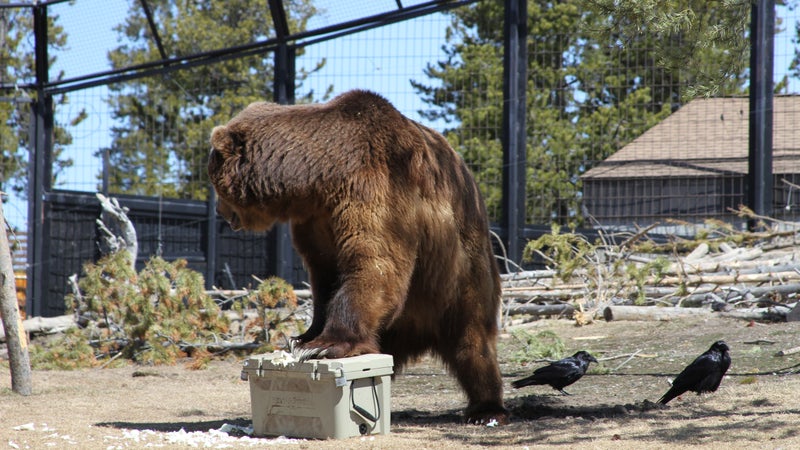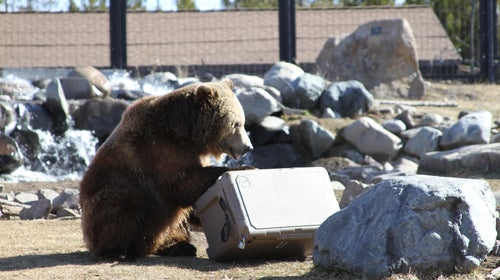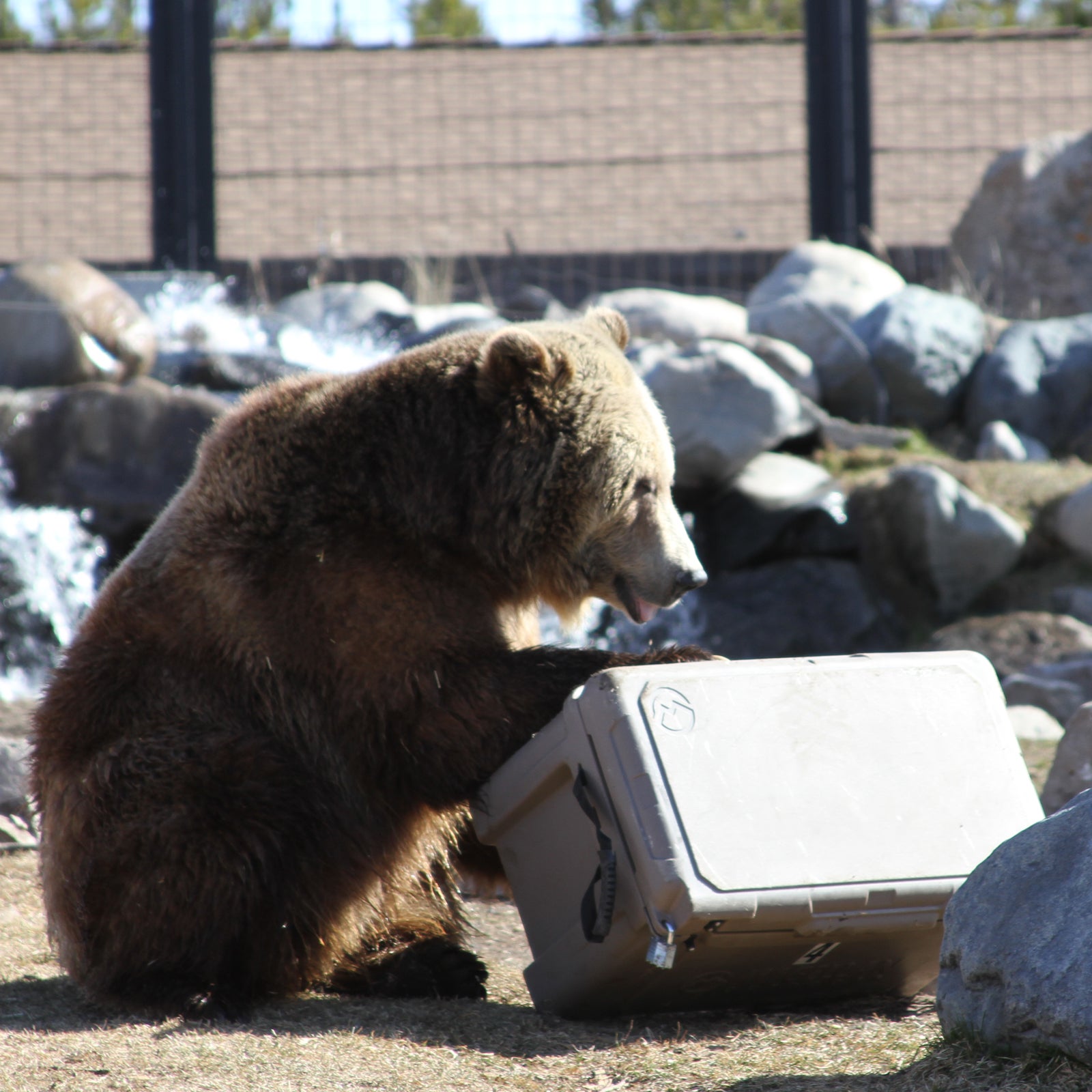When I was 23, I spent a summer working as a counselor at an overnight camp for eight-to-12-year-olds near the central mountain town of Genesee, Colorado. After a stern talking-to about what might happen if anyone went to bed with a snack in their sleeping bags—bears, people!—we’d zip the kids into their tents for the night, lock up the cabin containing our kitchen, and try to catch a few hours of sleep.
One morning around 5:30, after a particularly long night of comforting tearful, homesick tweens, I dragged myself into the kitchen for coffee. Two other counselors were already there, surveying the wreckage: a broken window, boxes of food strewn across the linoleum floor, burst bags of hot cocoa mix, and a maze of chocolaty paw prints. We’d assumed our supplies would be safe from intruders, but the flimsy windows were no match for a hungry bear.
That incident was a textbook case of food conditioning, according to wildlife biologist Wes Larson, who researches human-bear conflict. “A bear that breaks into someone’s campsite now understands that they can get this really calorie-dense food,” he explains. “It’s a huge payoff for relatively little effort, compared to spending hours picking berries.” The bear that broke into our camp kitchen was constantly doing a risk analysis—no matter how much she didn’t want to interact with humans, she was too tempted by the reward to stay away.
“That’s when they start doing un-beary things,” Larson says. In other words: they start getting into trouble.
Nearly every bear at the (GWDC) in West Yellowstone, Montana, has a similar backstory. The center is a nonprofit educational facility that houses grizzly bears unable to survive in the wild for one reason or another. It is also home to three small packs of captive-born wolves, a handful of injured raptors, and five American river otters.
When a wildlife official from anywhere in the American West, Alaska, or Canada has a nuisance grizzly bear and wants to avoid euthanizing it, the GWDC is often near the top of their call list. (Unfortunately, due to the center’s limited capacity, the answer is frequently that it can’t take another bear. In that case, says Randy Gravatt, the GWDC’s container testing coordinator, bears typically have to be euthanized.)
Coram, a male grizzly whose weight fluctuates between 550 and 680 pounds depending on the season, wandered through Kalispell, Montana, checking porches for dog kibble. Montana Fish, Wildlife, and Parks officials trapped him three times before he ended up at the GWDC. Spirit, a female grizzly, couldn’t stay away from a golf course in Whitefish; she was relocated six times—once as far as 100 miles away, but she kept finding her way back to that easy source of food—before one of her cubs was hit by a car and she was taken to the West Yellowstone facility.
Coram, Spirit, and the six other bears that live at the GWDC aren’t just wasting away in captivity, though. They have an important job to do: they test containers to determine whether they’re bear-resistant.
“It’s not just for the bears’ sake,” Gravatt says. “When bears become unafraid of humans, there’s potential harm to us, too.”
Every spring, Gravatt begins filling coolers, bike panniers, backpacking canisters, and trash dumpsters sent in by big-name manufacturers like Yeti, Cabela’s, Pelican, and Igloo with veggies, dry dog food, fish, honey, and—the bears’ favorites—peanut butter. “They don’t really like mushrooms or onions,” Gravatt says, adding that the bears will eat just about anything else in their quest to pack in around 15,000 calories per day during the summer (more when they’re getting ready to hibernate).
Once the containers are full of goodies, Gravatt gets them in front of the bears, which poke, prod, claw, bite, smash, and sometimes use what he calls “the CPR method,” wherein bears place their front paws atop a container and pump, almost as if they’re trying to revive the unfortunate object. If the container remains intact to a certain standard—gaps, tears, and holes can’t be larger than an inch for trash containers; for food containers, it’s a mere quarter-inch—it gets the bears’ literal seal of approval: a sticker depicting a grizzly’s head and shoulders and the product’s certification number. The GWDC is the only testing facility in the world where products can earn a certificate from the (IGBC).
The committee was formed in 1983, a decade after the Endangered Species Act made it clear that the grizzly bear, with its capital-e Endangered status, needed coordinated management. About 450 products—ranging from lightweight plastic bear canisters for backpacking to the heavy-duty coolers you might bring on a multiday river trip to industrial-grade metal dumpsters—have earned a place on the IGBC’s , says Scott Jackson, leader of the U.S. Forest Service’s National Carnivore Program and adviser to the IGBC.
The IGBC Executive Committee includes 13 representatives from major federal land agencies, including the National Park Service, Bureau of Land Management, U.S. Fish and Wildlife Service, U.S. Forest Service, and the governments of the four U.S. states where grizzlies are found (Washington, Idaho, Montana, and Wyoming), plus two Canadian partners. The committee meets twice a year to discuss local issues, educational programs, and other initiatives.
During the 1980s, urban sprawl and increased outdoor recreation meant that humans and bears were interacting more and more. The IGBC faced a growing challenge, Jackson explains, with grizzlies and garbage cans at local residences, campgrounds, and backpacking sites. So the IGBC came up with recommendations for keeping food and garbage away from them.
Later in the decade, the IGBC began issuing instructions on building homemade bear-resistant containers—mostly modified metal . They tested these products with mechanisms meant to simulate bears’ teeth and claws, attempting to exert similar force by dropping a weighted penetrometer mechanism—what Gravatt describes as a “pointy metal object”—onto them to mimic bites.
At the same time, the grizzly started to rebound—in the 1970s, according to the , there were fewer than 140 grizzly bears in the Greater Yellowstone Ecosystem (GYE); today, there are more than 700. The U.S. Geological Survey 73 grizzly bear deaths in the GYE in 2018, and at least 50 of those were known to be human caused, often related to habituation. Eventually, as outdoor recreation gained popularity and the market expanded, manufacturers started getting serious about mass-producing their own bear-resistant containers. But they needed an improved way to test them beyond the Wile E. Coyote–style experiments. What better way than to use actual bears, preferably ones that knew their way around a cooler?
That’s where Gravatt came in. Fifteen years ago, the IGBC asked if he’d help them formalize the program by using the bears that got there in the first place by getting into garbage. At the time, he was working as the GWDC’s facilities manager; he’d been helping fill in with animal-keeping duties because the center was short-staffed.
These days, the bears test a few dozen products every season. Manufacturers pay a fee, which helps cover Gravatt’s time, the bears’ myriad living expenses, and conservation and education efforts at the GWDC. Then they ship their containers to West Yellowstone, where Gravatt fills them with treats and lets the bears get to work. (Not all of the bears participate; 1,000-pound Sam is too big for all but special assignments, and Nakina, an Alaskan grizzly, simply doesn’t have any interest.)

The goal is to have the container last 60 minutes—by this time, a typical bear in the wild will have given up. Occasionally, Gravatt has to run the test a couple times before a GWDC bear remains interested even that long. The pass rate varies, Gravatt says, and hovered around 50 percent last year. Occasionally, a product fails right away: a bear figures out the mechanism or manages to gouge a big hole.
After every test, Gravatt examines the container and fills out a report. He sends the analysis back to the manufacturers, which can also opt for a videotape of the bears’ rigorous testing process. If the product passes, Gravatt notifies the IGBC, which issues a certification number for manufacturers to display on their products.
The seal matters. Food storage regulations on many public lands in grizzly country require IGBC-approved containers. It’s not just for the bears’ sake, Gravatt says. “When bears become unafraid of humans, there’s potential harm to us, too.”
Rules aside, wildlife biologist Larson says, front- and backcountry users have a responsibility to avoid conflict by storing food appropriately. “For us, an encounter can be life-changing,” he says. “For a bear, it can be a death sentence.”
In this way, the very bears that once broke into campsites and backyards—and, in some cases, came very close to being euthanized—contribute directly to reducing food conditioning in their wild counterparts. Coram and Spirit are at the GWDC for the rest of their natural lives, Gravatt says, but thanks to their testing, other bears may avoid the same fate.


